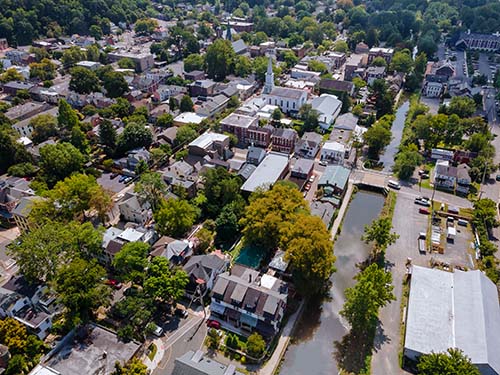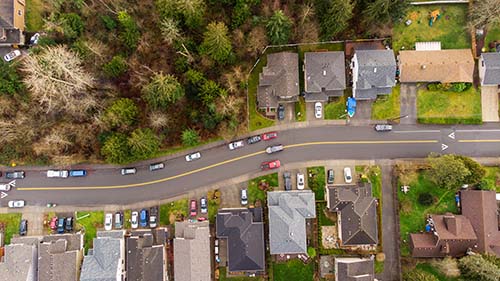Health is influenced by resource development through interrelated socioeconomic, ecological, cultural, and political pathways, which demand upstream, intersectoral responses. For example, both oil and gas production and the process of consumption (as it relates to climate change) have large impacts, both positive and negative, on social, economic and environmental systems that affect people’s mental health and overall wellbeing. These relationships are especially important in Canada, where the economy remains tightly coupled with the development of natural resources and where the rate and scale of social and environmental change occurring in resource-rich regions is fueling debate regarding health impacts, especially for rural, remote and Indigenous communities. To better understand these connections, the Canadian Institutes of Health Research funded three projects to look at how to understand and respond to the health impacts of climate change, and the relationship between a healthy natural world and healthy people. In this webinar, learn what researchers have discovered and where they plan to go next.
About the Projects
The ECHO (Environment, Community, Health Observatory) Network: Strengthening intersectoral capacity to understand and respond to health impacts of resource development
The ECHO Network is focused on working together across sectors to take notice of – and respond to – the influence of resource extraction on health and well-being, with specific emphasis on rural, remote and Indigenous communities and environments. ECHO brings together researchers and knowledge-holders across health, environment and community sectors who have identified the need to better understand and address the cumulative health, equity and ecological challenges of resource extraction and climate change. The ECHO Network is anchored in knowledge exchange partnerships in New Brunswick, Alberta, and British Columbia, with connections across Canada and Oceania. ECHO has developed a platform of integrative tools and processes to strengthen intersectoral capacity, and to connect people to information, practices and shared perspectives across generations and contexts. By focusing on integrative and collaborative responses to cumulative impacts of resource extraction and climate change, the ECHO Network has also identified new pathways of connection and co-benefits for health, including collective efforts that prioritise Indigenous leadership, champion equity and eco-social approaches to public health.
A SHARED Future: Achieving Strength, Health, and Autonomy through Renewable Energy Development for the Future
This research program, the only EHSI program that leads with Indigenous Ways of Knowing, focuses on bringing forward stories of reconciliation and healing in the context of intersectoral partnerships in renewable energy projects. The program’s research goal is to bring to light new and restored understandings of energy and integrative health. We examine how these partnerships may offer opportunities for a new era of nation-to-nation collaborations between Indigenous Peoples, organizations, and governments, with proponents, consultants, utilities, and state governments. Our program examines how Indigenous knowledge systems have the potential to lead us towards reconciling, healing, and decolonizing our relations with each other as well as the land, air, and water around us.
Patterns of Resilience Among Youth in Contexts of Petrochemical Production and Consumption in the Global North and Global South
This project assesses how young people adapt across the carbon cycle and use what we learn about their patterns of resilience to improve the lives of all youth. Both oil and gas production and the process of consumption (as it relates to climate change) have large impacts, both positive and negative, on social, economic and environmental systems that affect young people’s mental health and overall wellbeing. To better understand these complex relationships at both ends of the carbon cycle, a multidisciplinary and multisectoral team of researchers and community and industry partners in two communities in Canada (Drayton Valley in Alberta, Cambridge Bay in Nunavut) and two communities in South Africa (Dunoon in the Western Cape, Secunda in Mpumalanga) studied the resilience of young people and the systems with which they interact.
About the Speakers
The ECHO Network (Environment, Community, Health Observatory): Strengthening intersectoral capacity to understand and respond to health impacts of resource development
Margot Parkes is professor in the UNBC School of Health Sciences and co-lead of the UNBC Health Research Institute. She also co-leads the Environment, Community, Health Observatory (ECHO) Network, focused on the cumulative health, equity and ecological challenges of resource extraction and climate change. Drawing on her background in clinical medicine, public health, human ecology, ecohealth, Margot’s research focuses on integrative, partnered and Indigenous-informed approaches that connect social and ecological influences on health. Margot prioritises working and learning with others – across regions, cultural contexts, disciplines and sectors – to foster better understanding of land, water and living systems (ecosystems) as foundational for health, equity and well-being; to strengthen collaborations that reflect these connections, and that amplify co-benefits for people, place and planet.
Dr. Sandra Allison is Medical Health Officer at Vancouver Island Health Authority, Past President of the Public Health Physicians of Canada and Clinical Assistant Professor at the UBC School of Population and Public Health. She previously was Chief Medical Health Officer at Northern Health, and served as a regional medical health officer in Manitoba. She has extensive experience working with Indigenous people and rural and remote settings. In addition, she continues to work in primary care as a family physician. Dr. Allison was the Principal Knowledge User Applicant for the ECHO Network, founding co-chair of the ECHO Network Steering Committee between 2017-2019, and has remained an active knowledge exchange partner with the network since then.
Dr. Raina Fumerton is a public health physician and the Northwest Medical Health Officer at Northern Health. In addition to her generalist MHO responsibilities, Dr. Fumerton is the physician lead for the health protection portfolio and has a keen interest in environmental health, climate change, as well as the ecological and health/mental health/social/economic/cultural impacts of industrial development on the health of northern rural and remote communities. Since 2019, Dr. Fumerton contributed as the co-chair of the ECHO Network Steering Committee, as co-lead for the Northern BC regional case, and is actively involved as a knowledge exchange partner in the transition from the EHSI-funded ECHO Network to an ongoing pan-Canadian ECHO collective.
A SHARED Future: Achieving Strength, Health, and Autonomy through Renewable Energy Developments for the Future
Dr Heather Castleden (she/her) is a Professor and the President’s Impact Chair in Transformative Governance for Planetary Health at the University of Victoria. She is a white settler scholar, trained as a geographer, and she has been doing community-based participatory research in solidarity with Indigenous Peoples for over two decades. She is a former Canada Research Chair, Fulbright Scholar, and is now an elected member of the Royal Society of Canada’s College of New Scholars, Artists, and Scientists. Dr Castleden is the Co-Director of the ‘A SHARED Future’ research program and is the Scientific Director of the HEC Lab.
Dr Diana Lewis (she/her) is a member of the Sipekne’katik Mi’kmaq First Nation in Nova Scotia. She is an Assistant Professor and Canada Research Chair in Indigenous Environmental Health Goverance at the University of Guelph. Dr Lewis is a Co-Director of A SHARED Future. Her research interests are to foster a wider understanding of Indigenous worldviews and how Indigenous worldviews must inform environmental decisions, specifically as Indigenous peoples are impacted by resource or industrial development. She is a strong advocate for Indigenous data sovereignty and Indigenous-led decision making, and she is currently working with Indigenous communities across Canada to develop an Indigenous-led environmental health risk assessment approach.
Patterns of Resilience Among Youth in Contexts of Petrochemical Production and Consumption in the Global North and Global South
Michael Ungar, Ph.D., is the founder and Director of the Resilience Research Centre at Dalhousie University where he holds the Canada Research Chair in Child, Family and Community Resilience. In 2022, Dr. Ungar was ranked the number one Social Work scholar in the world in recognition of his ground-breaking work as a family therapist and resilience researcher. That work has influenced the way human adaptation in stressful environments and organizational processes are understood and studied globally, with much of Dr. Ungar’s clinical work and scholarship focused on the resilience of marginalized children and families, and adult populations experiencing mental health challenges at home and in the workplace.




 Dr. Oiamo is an Associate Professor in the Department of Geography and Environmental Studies at Toronto Metropolitan University. His research in environmental health geography focuses on exposure assessment through the development of environmental models of noise and air quality, novel population exposure metrics, and simulation systems to assess health impacts of urban change. These efforts complement research activities that aim to further our understanding of environmental determinants of health as well as health and disease risks in vulnerable urban populations. Through collaboration with public and private sector partners, these research activities are applied and oriented towards environmental decision-making and policy. Dr. Oiamo also teaches on topics related to environmental decision-making, sustainable development, demography and environmental health.
Dr. Oiamo is an Associate Professor in the Department of Geography and Environmental Studies at Toronto Metropolitan University. His research in environmental health geography focuses on exposure assessment through the development of environmental models of noise and air quality, novel population exposure metrics, and simulation systems to assess health impacts of urban change. These efforts complement research activities that aim to further our understanding of environmental determinants of health as well as health and disease risks in vulnerable urban populations. Through collaboration with public and private sector partners, these research activities are applied and oriented towards environmental decision-making and policy. Dr. Oiamo also teaches on topics related to environmental decision-making, sustainable development, demography and environmental health.




 Hanna Boogaard has more than 15 years of experience in air pollution epidemiology. She is a Consultant Principal Scientist at the Health Effects Institute (HEI) in Boston, MA, an independent research organization with balanced funding from the US Environmental Protection Agency and motor vehicle industry. She received a PhD in 2012 in air pollution epidemiology from Utrecht University, Netherlands. She studied health effects of traffic-related air pollution, and the effectiveness of traffic policy measures. At HEI, she is involved in research oversight and review of studies investigating the health effects of air pollution and studies evaluating the effectiveness of interventions to improve air quality and public health. In addition, she is involved in developing and overseeing new research programs on non-tailpipe traffic emissions, studies assessing adverse health effects of long-term exposure to low levels of ambient air pollution, and studies on health effects of traffic-related air pollution. Furthermore, she is working very closely with an expert HEI panel to systematically evaluate the evidence for the associations of long-term exposure to traffic-related air pollution with selected health outcomes. She holds a MSc in Epidemiology and Environmental Health Sciences (2005) from Maastricht University, Netherlands.
Hanna Boogaard has more than 15 years of experience in air pollution epidemiology. She is a Consultant Principal Scientist at the Health Effects Institute (HEI) in Boston, MA, an independent research organization with balanced funding from the US Environmental Protection Agency and motor vehicle industry. She received a PhD in 2012 in air pollution epidemiology from Utrecht University, Netherlands. She studied health effects of traffic-related air pollution, and the effectiveness of traffic policy measures. At HEI, she is involved in research oversight and review of studies investigating the health effects of air pollution and studies evaluating the effectiveness of interventions to improve air quality and public health. In addition, she is involved in developing and overseeing new research programs on non-tailpipe traffic emissions, studies assessing adverse health effects of long-term exposure to low levels of ambient air pollution, and studies on health effects of traffic-related air pollution. Furthermore, she is working very closely with an expert HEI panel to systematically evaluate the evidence for the associations of long-term exposure to traffic-related air pollution with selected health outcomes. She holds a MSc in Epidemiology and Environmental Health Sciences (2005) from Maastricht University, Netherlands.


 Ingrid Jarvis is a PhD candidate in the Department of Forest and Conservation Sciences at the University of British Columbia. She holds a BA in Psychology and a BSc in Natural Resources Conservation with Honours. Her CIHR-funded thesis examines how environmental exposures, including green and blue spaces, influence human health and development across the life course among Metro Vancouver residents. Her research focuses on early childhood and adult exposure to surrounding urban environments in relation to a range of health indicators. Her work takes an interdisciplinary approach by applying geospatial and epidemiological analyses that combine administrative, survey, and GIS data.
Ingrid Jarvis is a PhD candidate in the Department of Forest and Conservation Sciences at the University of British Columbia. She holds a BA in Psychology and a BSc in Natural Resources Conservation with Honours. Her CIHR-funded thesis examines how environmental exposures, including green and blue spaces, influence human health and development across the life course among Metro Vancouver residents. Her research focuses on early childhood and adult exposure to surrounding urban environments in relation to a range of health indicators. Her work takes an interdisciplinary approach by applying geospatial and epidemiological analyses that combine administrative, survey, and GIS data.


 Antonio Gomez-Palacio is an urban planner and founding partner with DIALOG, one of Canada’s leading design firms. Antonio’s professional experience and research focus on the intersection of architecture, planning, and urban design. He’s internationally recognized for transforming cities into vibrant urban places that respond to their social, economic, and environmental contexts. Antonio has worked on a wide range of projects focused on urban intensification, master planning, mixed-use, transit, heritage, economic development, and sustainability. His project work includes light-rail transit (LRT) projects for Mississauga, Brampton, and Edmonton, downtown plans for Halifax and Regina, and campus plans for Seneca College and Laurentian University.
Antonio Gomez-Palacio is an urban planner and founding partner with DIALOG, one of Canada’s leading design firms. Antonio’s professional experience and research focus on the intersection of architecture, planning, and urban design. He’s internationally recognized for transforming cities into vibrant urban places that respond to their social, economic, and environmental contexts. Antonio has worked on a wide range of projects focused on urban intensification, master planning, mixed-use, transit, heritage, economic development, and sustainability. His project work includes light-rail transit (LRT) projects for Mississauga, Brampton, and Edmonton, downtown plans for Halifax and Regina, and campus plans for Seneca College and Laurentian University.








 About the speaker:
About the speaker: